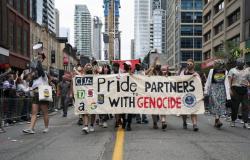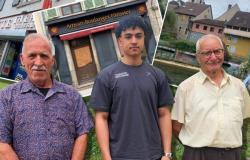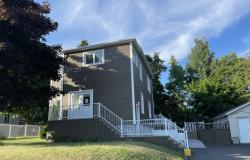The remains of a Newfoundland soldier killed on the battlefields of France during the First World War will be buried in St. John’s on Monday, culminating years of efforts.
Berkley Lawrence was part of the Newfoundland delegation that brought the soldier’s remains back from France last month for Monday’s ceremony, where the unknown soldier will be laid to rest in a black granite tomb at the National War Memorial in Saint-Jean.
M. Lawrence served in the Canadian military for 33 years and is now First Vice-President of the Royal Canadian Legion.
Open in full screen mode
Berkley Lawrence poses for a photo at the Royal Canadian Legion Branch 56 in St. John’s, Newfoundland, on June 25.
Photo: The Canadian Press / Paul Daly
His grandfather, Stephen Lawrencewas one of the 800 members of the Royal Newfoundland Regiment who, armed only with rifles and bayonets, attacked the Germans at Beaumont-Hamel on the morning of July 1, 1916.
More than 700 men were killed or injured. This frontal assault turned into a massacre that nearly wiped out the regiment.
Open in full screen mode
Aerial photo taken on June 10, 2016 of the Newfoundland Memorial in Beaumont-Hamel, France.
Photo : Associated Press
Stephen Lawrence was injured and was one of the few to return home to Newfoundland, his grandson said.
The unknown soldier we brought back could have been the person who stood next to my grandfather in the trenches before they went over the top
he said in a recent interview.
Disastrous battle, staggering number of deaths
Monday is Canada Day in the rest of the country, but in Newfoundland and Labrador, July 1 is the Memorial Day”,”text”:”Memorial Day”}}”>Memorial Day
.
It is a time to remember the hundreds of young men of Newfoundland Regiment who died in the disastrous battle in northern France, at a time when Newfoundland was not yet part of Canada.
This year also coincides with the 100th anniversary of the creation of the war memorial in St. John’s, Newfoundland.
The staggering death toll at Beaumont-Hamel is still being felt in Newfoundland today.
Open in full screen mode
The Newfoundland National War Memorial was dedicated on July 1, 1924. On Canada Day 2023, General Wayne Eyre (left), Chief of the Defense Staff, and his American counterpart Mark Milley (right) were participating in a ceremony.
Photo: The Canadian Press / Paul Daly
Soldiers from all over the province came to join the war effort. Losing so many soldiers during the First World War affected every community
argued Mr. Lawrence.
At the time, Newfoundland was a self-governing territory within the British Empire, home to approximately 240,000 people. These losses have affected us all.
.
The author Michael Crummeywho co-wrote Newfoundland at Armageddona documentary film about Beaumont-Hamel, said he was struck by how personal the loss was for the many people he spoke to in his research.
I think it’s because this place is so small and the connections between everyone are so close.
he said in an interview. The principle of six degrees of separation simply doesn’t apply here, it’s one or two. So it feels like all these losses have affected us all, that our lives would be completely different if World War I hadn’t happened.
The “lost nation of Newfoundland”
The war had other lasting consequences besides human losses, Mr. Crummey.
Newfoundland raised a huge amount of money to send its men to fight in the war, and the effort added about $35 million to the public debt, according to Heritage Newfoundland and Labrador.
Open in full screen mode
Newfoundland writer Michael Crummey at Middle Cove Beach, north of St. John’s, Newfoundland and Labrador, August 8, 2019.
Photo: The Canadian Press / Paul Daly
Newfoundland’s heavy debt ultimately influenced its leaders’ decision to bring Newfoundland back under British government control in 1934 and join Canada in 1949, Mr. Crummey.
July is a way to commemorate the lost nation of Newfoundland”,”text”:”In some ways, I think July 1st is a way to commemorate the lost nation of Newfoundland”}}”>In a way, I think July 1st is a way of commemorating the lost nation of Newfoundland.
did he declare. our feeling that Newfoundland is disappearing as a nation and becoming something different— from what happened at Beaumont-Hamel.”,”text”:”It is impossible to separate these elements — our sense that Newfoundland is disappearing as a nation and becoming something different — from what happened at Beaumont-Hamel.”}}”>It is impossible to separate these elements — our sense that Newfoundland is disappearing as a nation and becoming something different — from what happened at Beaumont-Hamel.
Open in full screen mode
People lined up outside the Confederation Building on Saturday to pay their respects to the remains of the unknown soldier, who lay in state there.
Photo : CBC / Henrike Wilhelm
Bringing the Unknown Soldier home and burying him at the National War Memorial may not put an end to the matter, but it will give people a place to put all those emotions, Mr. Crummey.
A symbol for all
Berkley Lawrence has been working alongside two other veterans for about seven years — Frank Sullivan et Gary Browne — to refurbish the monument.
M. Sullivanwho served in the regular and reserve forces for 42 years, came up with the idea of bringing the unknown soldier home.
Open in full screen mode
Frank Sullivan (left), Berkley Lawrence (center) and Gary Browne (right) at the Royal Canadian Legion Branch 56 in St. John’s, Newfoundland, June 25.
Photo: The Canadian Press / Paul Daly
Politicians, including the federal Minister of Labor, Seamus O’Reganwho represents a constituency in Saint-Jean, and the Prime Minister Andrew Fureyquickly joined the effort.
The Soldier’s Grave will represent Newfoundlanders and Labradorians who have died in all branches of service who do not have a known grave. The identity of the soldier will therefore not be investigated.
Open in full screen mode
The Governor General of Canada, Mary Simon, pays tribute to the Unknown Soldier on Sunday at the Confederation Building in St. John’s, Newfoundland.
Photo: Sgt Anis Assari, Rideau Hall © BSGG, 2024
But the members of the Royal Newfoundland Regiment wore clear markings on their uniforms — a caribou button or Newfoundland patches on the shoulder — declaring their allegiance, Mr. Lawrence.
He’s preparing for an emotional day Monday, but he also expects to feel a sense of relief once the soldier is buried. He hopes that feeling will resonate throughout the province.
The remains of the unknown soldier are on display at the Confederation Building in Saint John from Friday until Sunday.
Acadia Newsletter
Subscribe to the Acadie newsletter.






